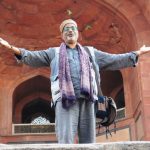-
Conservation of a unique city, Chandigarh
April 2012

Rough sketch of the site
Chandigarh, the capital of Haryana and Punjab was designed by the distinguished French (born Swiss) Architect and Urban Planner, Le Corbusier in the 1950s. It was the Architect’s largest project. Chandigarh is not only considered as one of the greatest architectural works but also unique because it is the only example of a city constructed entirely on a plan and realised on an empty site. 60 years ago the city not only served as an urban centre but also represented India as a liberated, democratic, forward-looking state. Today it is a city of quarter of a million people, and is under pressure with regards to maintenance. Its architectural buildings and detailed furnishings by Pierre Jeanneret are beginning to show years of neglect. A group of local architects, art historians and officials are hoping to mobilise international help to prevent further damage to Le Corbusier’s unique Indian legacy. Chandigarh is also seeking protection under a UNESCO World Heritage Site designation. As Doriana and Massimiliano Fuksas comments “in a city there are not noble buildings and less noble ones, that’s the whole that constitutes a unique heritage. We must preserve the city system that underlies the contemporary beauty of the city itself.”













